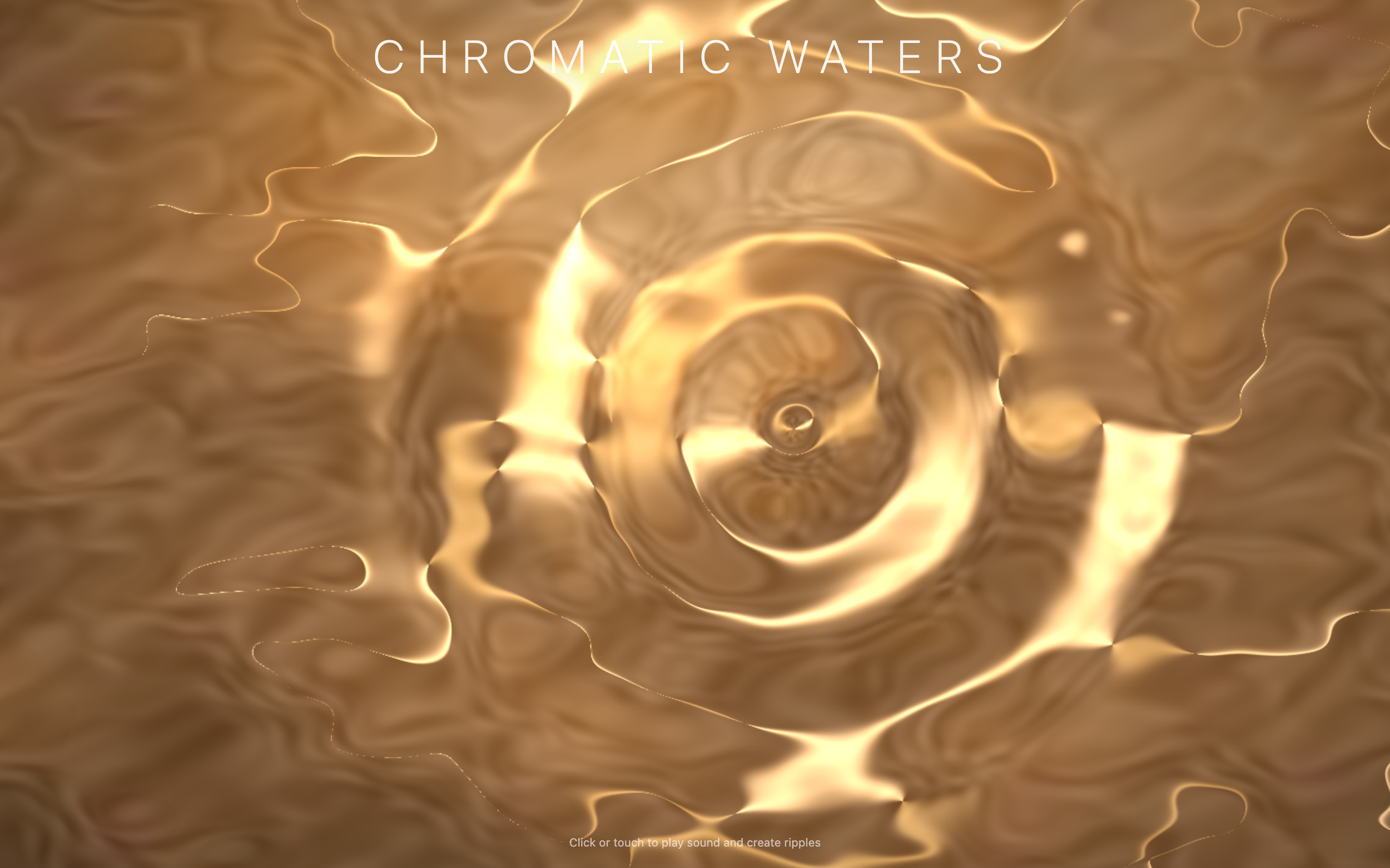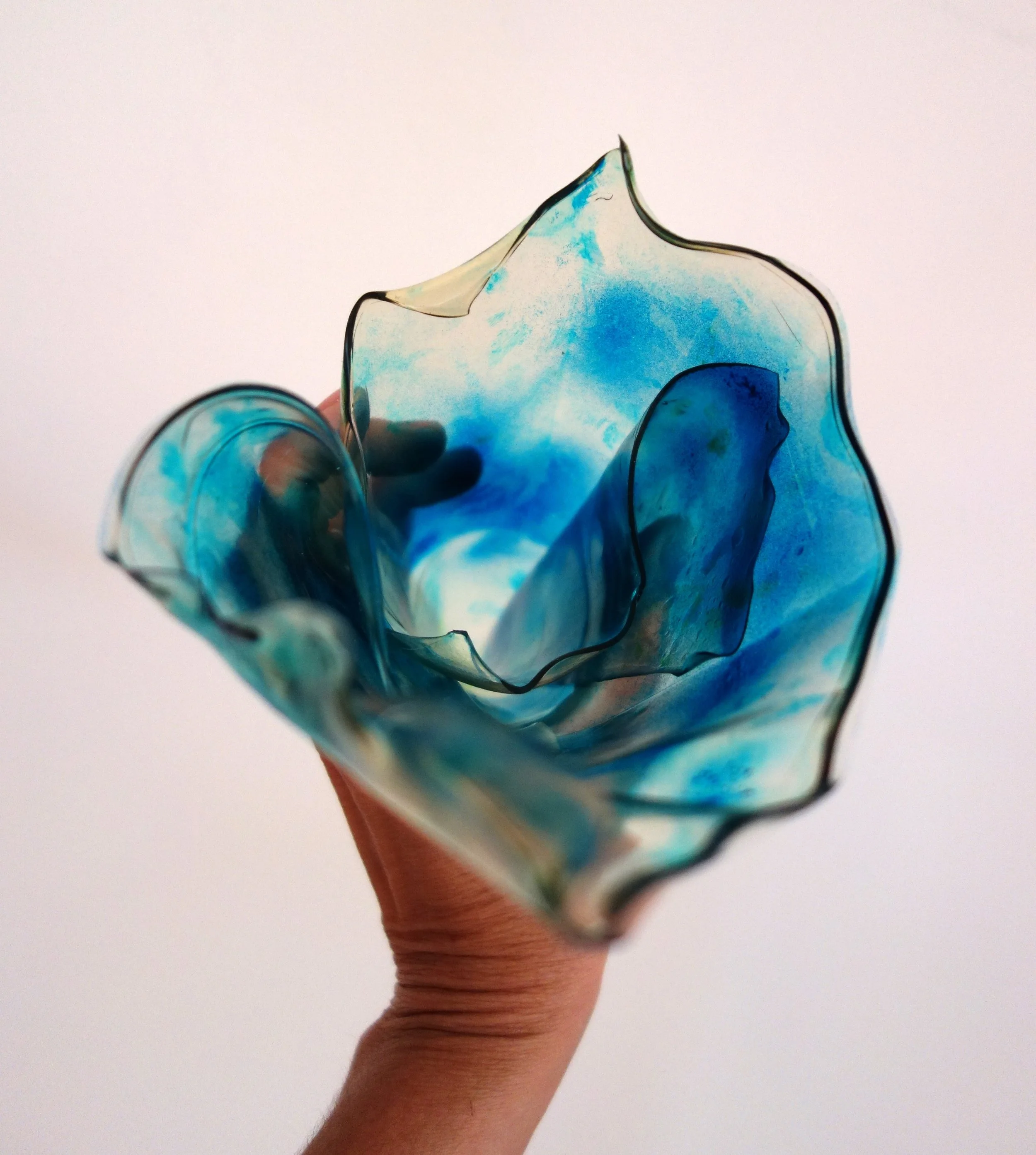
Searching for diffracting I
Cyanotype on cotton fabric with natural wool from Argentina.

Chromatic waters (2025)
Explore: https://chromatic-waters.vercel.app/
This interactive digital sound piece forms part of a broader investigation into environmental acoustics, sensor-based technologies, and the material poetics of place. Recorded underwater in the Calamuchita and Suquía rivers of Córdoba, Argentina, the work draws from the canto rodado — the resonant friction between rock and current. Through this interplay of softness and solidity, motion and rest, the piece invites a sensory encounter with a landscape in constant change. It is an encounter between hardness and softness, stillness and flow, freedom and weight — a conversation between the river’s body and its moving breath.

The Humidity Reader (2025)
Medium and materials: humidity and temperature, plant, soil, water, sunlight
Technology: Arduino + DHT22 sensor (humidity and temperature data), OpenFrameworks for real-time sound and visualization
This ongoing experiment translates environmental data from a living plant into generative sound and motion graphics. Variations in light, humidity, and temperature produce shifting tones and rhythms, allowing the environment to “compose” its own score. The work explores how technology can serve as a translator of ecological intelligence, revealing patterns of communication between living systems and digital interpretation.
Through this prototype, I have become increasingly aware of the energetic and material footprint of the tools that make such translation possible. This insight opens a critical inquiry for my next phase of research: how to design low-power, biodegradable, or repairable interfaces that minimize waste while maintaining sensory richness. The project thus becomes both an artwork and a test site for rethinking technology’s role within regenerative ecosystems.

The humidity reader
The air speaks — The Humidity Reader listens.
Slightly sweaty, totally fabulous. 100% attitude.
I ❤️ sound art
Medium and materials: humidity and temperature, plant, soil, water, sunlight
Technology: Arduino + DHT22 sensor (humidity and temperature data), OpenFrameworks for real-time sound and visualization
This ongoing experiment translates environmental data from a living plant into generative sound and motion graphics. Variations in light, humidity, and temperature produce shifting tones and rhythms, allowing the environment to “compose” its own score. The work explores how technology can serve as a translator of ecological intelligence, revealing patterns of communication between living systems and digital interpretation.
Through this prototype, I have become increasingly aware of the energetic and material footprint of the tools that make such translation possible. This insight opens a critical inquiry for my next phase of research: how to design low-power, biodegradable, or repairable interfaces that minimize waste while maintaining sensory richness. The project thus becomes both an artwork and a test site for rethinking technology’s role within regenerative ecosystems.

The Sea Is a Soft Machine (2025)
Materials: organic cotton textile (2 x 5 m) painted with añil (indigo) dye from Santiago de Niltepec, Oaxaca, hand-embroidered
with naturally dyed cotton cords; includes 20 spherical magnets, six metal pulleys, and custom motion elements, stainless-steel spheres, seed pods, a round mirror, and a found child’s chair sculpted with natural pigments,
bioplastics (potato starch), and sea salt.
Technology: mechanical servo motors, Arduino board, and video projection.
This installation and performance weave textile, pigment, sound, and motion into an evolving environment where blue becomes both memory and threshold—sea, body, and fabric echoing each other through vibration and breath.
Activated by a live sound performance at LM Studio, the piece transforms the gallery into a fluid space of resonance and movement. The work resembles a fragile prototype and envisions the sea as a living interface—a soft machine that connects human gestures, mechanical rhythms, and ecological imagination. By utilizing indigo-dyed textiles made through traditional Oaxacan and Japanese techniques, it bridges the gap between traditional craftsmanship and contemporary experimentation. By combining organic materials, found objects, and small mechanical systems, “The Sea Is a Soft Machine” reflects on the complex relationship between human technology and creation, as well as our interdependence with nature, technology, and memory, highlighting our complex relationship with the vast sea.

The sea is a soft machine (2025) – Detail
A found child’s chair sculpted with bioplastic (potato starch), sea salt, and natural pigments.

Fire of the Sun, the Earth, and My Heart… (2025, Oaxaca, Mexico)
Medium: geomantic fresco mural created with Mayan and mineral pigments, integrating principles of solar geometry and geomancy.
This mural embodies an alignment between earth, fire, and sky, guided by sacred numbers, the solar calendar, and the site’s energetic orientation. Its geometry follows the rhythms of the sun, transforming the wall into a living compass that channels light and resonance throughout the day.
Developed in collaboration with geomancer Rocío Araujo and muralist Jesús González of the Oaxacan school of muralism, the work bridges ancestral wisdom and contemporary ecological art. Fire of the Sun, the Earth, and My Heart… reclaims muralism as a ritual of place—a way of drawing energy from the land to renew our dialogue with the elements and the cosmic cycles that sustain life.

Sculpture for and with spiders (2024, Etla, Oaxaca, Mexico)

Seeds of Light, Breath of the Earth (2025, Oaxaca, Mexico)
Materials: handmade paper composed of pochote fiber (softened by cooking with sodium carbonate) and white cotton, incorporating mica mineral and natural tinctures of cempasuchil, grana cochinilla from nopal, granada, and añil (or indigo).
This work emerges from a process of material listening—mixing botanical dyes and earth-based substances into the pulp to let color, light, and seed interact as living elements. It unfolds as an act of transformation and renewal, where vegetal, mineral, and pigment coalesce into living matter. The paper becomes a terrain of metamorphosis: pigments bleed and fuse, mica captures fleeting reflections, and coriander seeds hold the potential of future growth. Its luminous surface arises from the dialogue between fibers, dyes, and embedded minerals—each element capturing memory differently. The ochres and blues recall earth and sky, while cochineal and marigold carry the warmth of fire and sun. Created through traditional Oaxacan papermaking methods, the piece becomes both surface and soil—a meditation on fertility, impermanence, and the regenerative intelligence of materials, where matter records the memory of its making.

Translucent Organism (2024, Brooklyn, NY)
Materials: gelatin, glycerin, sodium propionate, and blue food pigment.
This biopolymer sculpture explores the fluid boundary between organic and synthetic matter. Created through a process of controlled heating, cooling, and spontaneous deformation, the material retains a fragile translucency that evokes marine membranes and vegetal tissues. As it dries, it bends and curls into unpredictable forms, embodying both growth and decay in a single gesture.
While I have long worked with fabrics, paper, water-based media, found objects, and technology, Translucent Organism marked a turning point in my practice: the beginning of my research into biomaterials as regenerative living archives, translating laboratory learning into a sensory meditation on ecological temporality, fragility, and care.

Combonauta: Vessel for Light and Soil (2025, Oaxaca, Mexico)
Materials: Lamp — rice paper, lime and soil pigments, fiber weaving dyed with cempasuchil and palo de Brasil, seashell pendants collected from the Oaxacan coast. Paper hat — paper pulp painted with beet tincture. Textile ground — cotton fabric prepared with eucalyptus and painted with soil from the Mixteca region, Oaxaca.
Combonauta is a paired work—a garment and a lamp—that reflects on illumination, protection, and transformation through material alchemy. The lamp, woven from vegetal fibers and rice paper, emits a soft, earthen glow filtered through pigments of cempasuchil, lime, and palo de Brasil. At the same time, small seashells murmur with coastal memory. The paper hat, tinted with beet tincture, and the earth-painted textile beneath it form a ritual ensemble that bridges the body and landscape, soil and light.
Together, these pieces evoke the idea of the traveler or “combonauta”—one who navigates cycles of matter and meaning. They embody a sensorial dialogue between organic materials and human craft, transforming acts of dyeing, painting, and weaving into gestures of care for the land.
Creative ecology of imagination










